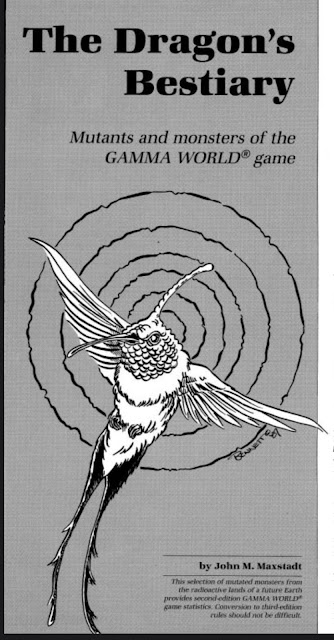Buzzbird
I thought it might be nice to present this Gamma World critter in its original form. This monster comes from Dragon Magazine, issue #126, Volume 12, number 5, October 1987, in an article entitled The Dragon’s Beastiary, Mutants and Monsters of The Gamma World game by John M. Maxstadt.
Buzzbirds (Flitters)
NUMBER: 1d20 -8 (minimum of 1)
MORALE: 1d4 + 1
HIT DICE: 2d6
ARMOR: 10 (-7 to be hit)
SIZE: 7 cm tall
AIR SPEED: 2/1200/30
MS: 3d6
IN: 1d8 + 8 DX: 1d10 + 11 CH: 1d12 + 4 CN: 1d4 + 2 PS: 1d4
ATTACKS: See below.
ORIGINAL STOCK: Ruby-throated hummingbird.
MUTATIONS: Light generation (variant), sonic attack (variant), speed increase (improved), and telepathy.
HABITAT: Warm, temperate and tropical scrublands.
DIET: Flower nectar and very small insects.
Sonic Attack Effects Table
1d10 roll. Attack effect
1-3. Creature falls on the ground holding its ears for two action turns or for the duration of the buzz, whichever is shorter.
4-5 Creature runs away at top speed for three minutes.
6-7 Creature runs around in circles, or otherwise moves rapidly and aimlessly in the same area for two action turns or for the duration of the buzz, whichever is longer.
8-9 Creature physically attacks the nearest other creature at +2 to hit and double damage for two turns or for the buzz duration, which- ever is longer.
10 Creature attacks the nearest object, as above. If no object is within arms reach, the creature may attack the ground (but not itself or its own gear).
DESCRIPTION:
The buzzbird is extremely dextrous and fast-moving. It seldom lights unless it believes it is absolutely safe. In general, buzzbirds are friendly to intelligent creatures and frequently associate with lils. They are also peculiarly attracted to the color red, and react at a +2 modifier to creatures which are red or primarily clothed in red. They seldom attack anything except to defend themselves or their friends.
The buzzbirds sonic attack does no hit- point damage, but it affects the nervous system of creatures so endowed. It hits as a mental attack of MS 7, and does not affect unintelligent plants, invertebrates, or deaf creatures. If a creature is affected, the GM should roll 1dl0 on the appropriate table.
Affected creatures do not recognize friends if an 8, 9, or 10 is rolled on the table. They rarely attack the buzzbird, which attacks while flying rapidly past its opponents. The attack affects all creatures, friend or foe, within a S-meter radius, and is +2 to hit creatures with better-than-human hearing. Covering ones ears has no effect on this attack. The buzzbird can continue this attack nonstop for an indefinite period of time. If a creature recovers from one of the effects on the table but is still in the area of effect of the buzz, a new attack should be rolled; if the creature is affected again, a new 1d10 should be rolled on the table.
Buzzbirds may use their speed increase one hour per day, as usual, but they may split that hour up into smaller units (as little as one action turn) if they so desire. Their light generation has a smaller radius (10 meters) than usual and is not directional, since it emanates from their bodies rather than their eyes.
I do believe S-meter radius maybe a typo. S-meter is used to measure signal strength however this is not very practical for a game such as Gamma World and I have chosen at this time to consider it a to be a 5 meter radius.



Comments
Post a Comment